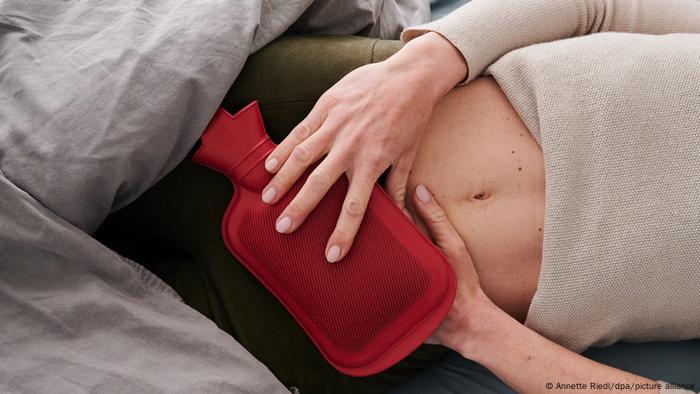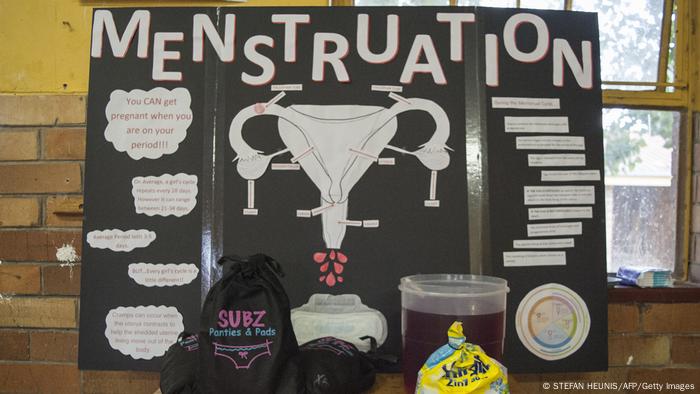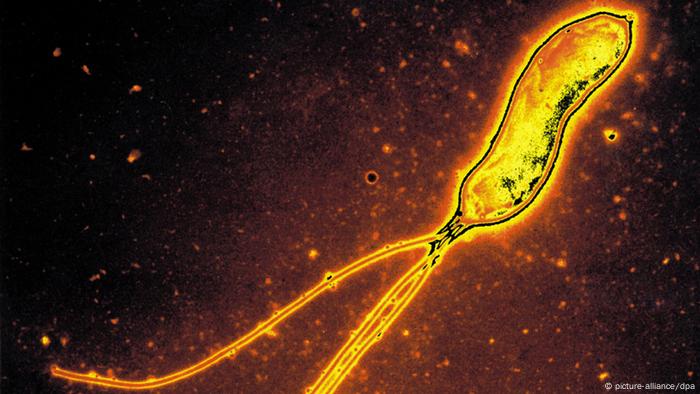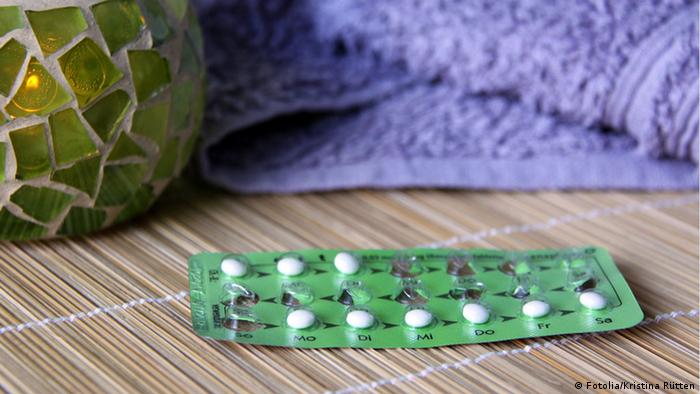About 60 percent of all women develop a fibroid at some point. Although such a tumor is benign, it can cause severe discomfort and pain. However, there are some promising therapies.
 < p>Fibroids can cause abdominal pain
< p>Fibroids can cause abdominal pain
Fibroids occur in women all over the world, from Asia to Africa. According to a new study from the USA, 20 to 77 percent of all women worldwide have a fibroid. There are no more precise figures, because fibroids are usually recognized late, if at all.
They are usually detected in a Routine examination discovers or if fibroids cause symptoms. The number of unreported cases is correspondingly high, with fibroids occurring 59 percent more frequently in women with dark skin – people of color – as the study also showed. The exact reasons for this are not known.
It affects most women between the ages of 25 and 50. The causes of its development are still unknown. Researchers assume that both a genetic predisposition and the female sex hormones play a role, because after menopause the probability of developing another form of myoma is almost zero.
So-called submucosal fibroids form under the lining of the uterus, intramural fibroids grow in the muscular layer and subserous fibroids grow on the outside of the uterus. The doctor can usually feel myomas during a gynecological examination or discover them in an ultrasound. They are not dangerous, they are benign tumors. But they can cause various symptoms.
These are the most common symptoms
Every woman has different symptoms. For example, they depend on the size and location of the fibroids.
The first signs of a fibroid can be pain in the abdomen or in the pelvic area. A fibroid can also cause heavy menstrual bleeding, which often lasts for a long time. In the worst case, this can lead to anemia and, as a result, to dizzy spells. Another possible sign is bleeding between periods.
If these are particularly severe, the person concerned should consult a doctor. They will then clarify whether it is actually a fibroid or a malignant tumor. In any case, it is important to consult an expert. However, it is almost never the case that a benign fibroid develops into a malignant tumour.

Symptoms from fibroids often increase during menstruation
In the case of a small fibroid, the doctor will probably advise only observing the benign tumors at regular intervals. Most fibroids are smaller than five centimetres, but extremely large fibroids weighing several kilograms have also been removed. Such large specimens can certainly press on adjacent organs and thus trigger further complaints.
If the urinary bladder is affected, it can lead to a strong, unpleasant urge to urinate, which can sometimes no longer be controlled. Back and kidney pain can also have their origin in a fibroid, as can non-specific pain in the legs. In order to associate these symptoms with a fibroid, the doctor must have some experience and also know which therapy is appropriate in each individual case.
There are many gentle therapies
Surgeons can surgically remove a fibroid. This is usually done minimally invasively, i.e. the tumor is removed during a hysteroscopy or a laparoscopy.
A so-called embolization is also often an option. A doctor inserts plastic particles into the artery, which normally supplies the fibroid with blood. The particles interrupt the blood supply and block the transport of other important substances. The fibroid is thus cut off from the supply and subsequently shrinks.
A relatively young therapy method is the so-called transcervical radio frequency ablation. Electrodes are inserted through the cervical canal and heat is directed at the fibroid. This treatment also causes the growth to become smaller.
It's more complicated when the fibroid is particularly large. Then there is usually a hysterectomy, in which the entire uterus is removed. However, such an operation is only performed if all other therapies have failed and a gentle removal of the fibroid is not possible.
Which method the doctor uses also depends on whether there is a desire to have children and ultimately on good and sensitive advice, in which the patient is informed exactly about the advantages and disadvantages of the methods and can help decide which therapy is the best.
-
 Avoiding cancer instead of curing it
Avoiding cancer instead of curing it
Fate is in your hand
A cancer diagnosis is always hard and unexpected. Almost half of all cancer cases could be avoided. Smoking is to blame for about every fifth tumor. The toxic tobacco smoke not only causes lung cancer, but also many other types of tumours. Smoking is the most common self-inflicted cause of cancer – but not the only one.
-
 Avoiding cancer instead of curing it
Avoiding cancer instead of curing it
Being fat can be deadly
The second most common cause of cancer: obesity. High insulin levels are to blame. They increase the risk of almost all types of cancer, especially kidney, gallbladder and esophageal cancer. Overweight women also produce more female sex hormones in adipose tissue and are therefore more likely to develop uterine and breast cancer.
-
 Avoiding cancer instead of curing it
Avoiding cancer instead of curing it
Get off the sofa!
People who hardly move are particularly likely to get cancer. Long-term studies show: Sport prevents tumors. Physical activity lowers insulin levels and also prevents you from getting fat. And it doesn't have to be a high-performance sport: just a little walk or bike ride makes a big difference.
-
 Avoiding cancer instead of curing it
Avoiding cancer instead of curing it
Cancer for the good!
Alcohol is carcinogenic. It primarily promotes tumors in the oral cavity, the pharynx and the esophagus. The combination of smoking and alcohol is particularly dangerous: This increases your risk of cancer a hundredfold. However, a glass of wine a day is healthy because it supports the cardiovascular system. Anything beyond that should be avoided.
-
 Avoiding cancer instead of curing it
Avoiding cancer instead of curing it
Unhealthy things from animals
Red meat can cause colon cancer. The exact reason has not yet been clarified, but long-term studies show a clear connection. Beef is particularly dangerous, and to a lesser extent, pork. Consumption increases the risk of cancer by a factor of one and a half. Fish, on the other hand, prevents cancer.
-
 Prevent cancer instead of curing it < h2>Danger from the charcoal grill?
Prevent cancer instead of curing it < h2>Danger from the charcoal grill?
Carcinogenic substances such as polycyclic aromatic hydrocarbons are produced when meat is grilled. In animal experiments, these chemical compounds trigger tumors. This has not yet been clearly proven in long-term studies on humans. It's possible that eating the meat is the problem, not the way it's cooked.
-
 Avoiding cancer instead of curing it
Avoiding cancer instead of curing it
Avoid fast food
A diet high in fruits, vegetables, and fiber helps prevent cancer. In long-term studies, however, researchers have seen that a healthy diet has less of an impact on the risk of cancer than originally thought: it only reduces the risk slightly, by no more than ten percent.
- < img src="https://static.dw.com/image/16159606_303.jpg" /> Avoiding cancer instead of curing it
A lot of sun is bad for you
UV radiation in sunlight penetrates the genome and changes it. The result: black or white skin cancer. Sunscreen protects against sunburn – but as soon as the skin tans, it has already received too much radiation.
-
 Preventing cancer instead of curing it
Preventing cancer instead of curing it
Cancer through modern medicine
X-rays damage the genetic material. With an ordinary X-ray, however, the exposure is low. Completely different with a computed tomography: You should only undergo it if there are good reasons. Magnetic resonance imaging, on the other hand, is harmless. By the way: You are also exposed to carcinogenic radiation when you fly.
-
 Avoiding cancer instead of curing it
Avoiding cancer instead of curing it
Cancer through infections
Human papillomavirus can cause cervical cancer. Hepatitis B and C viruses can cause liver cells to degenerate. The bacterium Helicobacter pylori (photo) nests in the stomach and can be the cause of stomach cancer. You can get vaccinated against many of the pathogens, and antibiotics help against Helicobacter pylori.
-
 Preventing cancer instead of curing it
Preventing cancer instead of curing it
Better than its reputation
Although the contraceptive pill slightly increases the risk of developing breast cancer, it also greatly reduces the risk of ovarian cancer. Overall, the pill protects more than it harms – at least as far as cancer is concerned.
-
 Avoiding cancer instead of curing it
Avoiding cancer instead of curing it
A true stroke of fate
But even if you do everything right – you are never completely immune to cancer. Half of all cancer cases are caused solely by the wrong genes – or simply by age. Brain tumors in particular often develop without external intervention.
Author: Brigitte Osterath
 < p>Fibroids can cause abdominal pain
< p>Fibroids can cause abdominal pain
 Avoiding cancer instead of curing it
Avoiding cancer instead of curing it Avoiding cancer instead of curing it
Avoiding cancer instead of curing it Avoiding cancer instead of curing it
Avoiding cancer instead of curing it Avoiding cancer instead of curing it
Avoiding cancer instead of curing it Avoiding cancer instead of curing it
Avoiding cancer instead of curing it Prevent cancer instead of curing it < h2>Danger from the charcoal grill?
Prevent cancer instead of curing it < h2>Danger from the charcoal grill?
 Avoiding cancer instead of curing it
Avoiding cancer instead of curing it Preventing cancer instead of curing it
Preventing cancer instead of curing it Avoiding cancer instead of curing it
Avoiding cancer instead of curing it Preventing cancer instead of curing it
Preventing cancer instead of curing it Avoiding cancer instead of curing it
Avoiding cancer instead of curing it